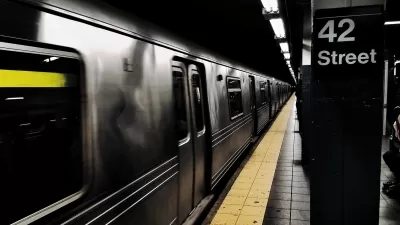Communications Based Train Control (CBCT) will allow New York City's subways to run more efficiently than ever. But like with all service improvements, implementation will take some time and patience, write Josef Szende and Charles Komanoff.
"Whereas the century-old system now in use relies on block signals with colored lights alongside the track to tell operators if they're too close to the train ahead, CBTC uses radio signals to locate all of the trains on the line. With this information, on-board computers can calculate the distance between trains precisely and in real time, letting operators run trains closer together without compromising safety.
With more trains per hour, wait times will diminish and trains should be less crowded - allowing for increased ridership as the experience of riding the subway becomes more convenient and pleasant. Adding just one train per hour adds space to move another 2,640 people. That translates to fewer times waiting while a packed train goes by, and fewer elbows in your ear when you board."
Thanks to Georgia Bullen
FULL STORY: New Tech Promises Less Subway Crowding, If Albany Doesn’t Beggar the MTA

Alabama: Trump Terminates Settlements for Black Communities Harmed By Raw Sewage
Trump deemed the landmark civil rights agreement “illegal DEI and environmental justice policy.”

Planetizen Federal Action Tracker
A weekly monitor of how Trump’s orders and actions are impacting planners and planning in America.

The 120 Year Old Tiny Home Villages That Sheltered San Francisco’s Earthquake Refugees
More than a century ago, San Francisco mobilized to house thousands of residents displaced by the 1906 earthquake. Could their strategy offer a model for the present?

In Both Crashes and Crime, Public Transportation is Far Safer than Driving
Contrary to popular assumptions, public transportation has far lower crash and crime rates than automobile travel. For safer communities, improve and encourage transit travel.

Report: Zoning Reforms Should Complement Nashville’s Ambitious Transit Plan
Without reform, restrictive zoning codes will limit the impact of the city’s planned transit expansion and could exclude some of the residents who depend on transit the most.

Judge Orders Release of Frozen IRA, IIJA Funding
The decision is a victory for environmental groups who charged that freezing funds for critical infrastructure and disaster response programs caused “real and irreparable harm” to communities.
Urban Design for Planners 1: Software Tools
This six-course series explores essential urban design concepts using open source software and equips planners with the tools they need to participate fully in the urban design process.
Planning for Universal Design
Learn the tools for implementing Universal Design in planning regulations.
Clanton & Associates, Inc.
Jessamine County Fiscal Court
Institute for Housing and Urban Development Studies (IHS)
City of Grandview
Harvard GSD Executive Education
Toledo-Lucas County Plan Commissions
Salt Lake City
NYU Wagner Graduate School of Public Service




























